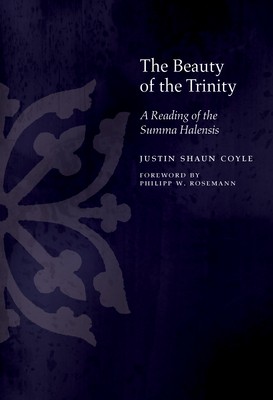
- We will send in 10–14 business days.
- Author: Justin Coyle
- Publisher: Fordham University Press
- ISBN-10: 153150003X
- ISBN-13: 9781531500030
- Format: 15.2 x 22.9 x 1.8 cm, hardcover
- Language: English
- SAVE -10% with code: EXTRA
Reviews
Description
In this book Justin Shaun Coyle remembers the theology of beauty of the forgotten Summa Halensis, an early-thirteenth-century text written by Franciscan friars at the University of Paris. Many scholars vaunt the Summa Halensis--conceived but not drafted entirely by Alexander of Hales (d. 1245)--for its teaching on beauty and its influence on giants of the high scholastic idiom. But few read the text's teaching theologically--as a teaching about God. The Beauty of the Trinity: A Reading of the Summa Halensis proposes an interpretation of the Summa's beauty--teaching as deeply and inexorably theological, even trinitarian.
The book takes as its keystone a passage in which the Summa Halensis identifies beauty with the "sacred order of the divine persons." If beauty names a trinitarian structure rather than a divine attribute, then the text teaches beauty where it teaches trinity. So The Beauty of the Trinity trawls the massive Summa Halensis for beauty across passages largely ignored by the literature. Taking seriously the Summa's own definition of beauty rather than imposing onto the text modernity's narrow aesthetic categories allows Coyle to identity beauty nearly everywhere across the text's pages: in its teaching on the transcendental determinations of being, on the trinity proper, on creation, on psychology, on grace. A medieval text must teach beauty that appreciates beauty theologically beyond the constricted and anachronistic boundaries that often limit study of medieval aesthetics. Readers of medieval theology and theological aesthetics both will find in The Beauty of the Trinity a depiction of how an early scholastic summa thinks beauty according to the mystery of the trinity.EXTRA 10 % discount with code: EXTRA
The promotion ends in 18d.22:35:33
The discount code is valid when purchasing from 10 €. Discounts do not stack.
- Author: Justin Coyle
- Publisher: Fordham University Press
- ISBN-10: 153150003X
- ISBN-13: 9781531500030
- Format: 15.2 x 22.9 x 1.8 cm, hardcover
- Language: English English
In this book Justin Shaun Coyle remembers the theology of beauty of the forgotten Summa Halensis, an early-thirteenth-century text written by Franciscan friars at the University of Paris. Many scholars vaunt the Summa Halensis--conceived but not drafted entirely by Alexander of Hales (d. 1245)--for its teaching on beauty and its influence on giants of the high scholastic idiom. But few read the text's teaching theologically--as a teaching about God. The Beauty of the Trinity: A Reading of the Summa Halensis proposes an interpretation of the Summa's beauty--teaching as deeply and inexorably theological, even trinitarian.
The book takes as its keystone a passage in which the Summa Halensis identifies beauty with the "sacred order of the divine persons." If beauty names a trinitarian structure rather than a divine attribute, then the text teaches beauty where it teaches trinity. So The Beauty of the Trinity trawls the massive Summa Halensis for beauty across passages largely ignored by the literature. Taking seriously the Summa's own definition of beauty rather than imposing onto the text modernity's narrow aesthetic categories allows Coyle to identity beauty nearly everywhere across the text's pages: in its teaching on the transcendental determinations of being, on the trinity proper, on creation, on psychology, on grace. A medieval text must teach beauty that appreciates beauty theologically beyond the constricted and anachronistic boundaries that often limit study of medieval aesthetics. Readers of medieval theology and theological aesthetics both will find in The Beauty of the Trinity a depiction of how an early scholastic summa thinks beauty according to the mystery of the trinity.

Reviews